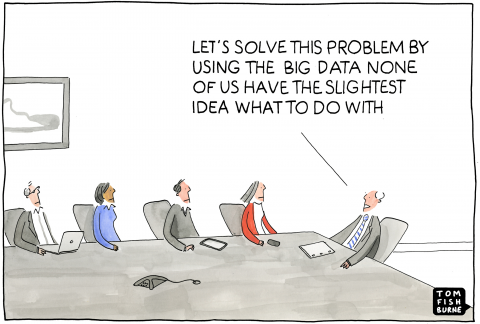
Several years ago, I was part of a small group of people working very long hours in a small flat in South London. By some minor miracle of luck and ignorance, as the founders of our newly formed digital business we made a series of very simple, unanimous and ultimately very good decisions. We decided that we would compromise somewhat on the scale of the traffic we were so keenly attracting to our recently launched financial website and focus instead on a more qualitative approach with regards to our content and commit to constantly figuring out genuine reasons for users to register. We also went about creating a centralised data depo sitory, establishing some basic rules around governance and usage, but also wanted to try and measure everything that we possibly could.
sitory, establishing some basic rules around governance and usage, but also wanted to try and measure everything that we possibly could.
We didn’t really realise it at the time – but we had agreed upon our future data strategy as a small digital business with these basic principles and then just frantically got to work. These principles stood us in great stead as we grew and caused the IT guys some serious headaches as the creative juices started flowing and the various data-related projects dramatically scaled. Particularly related to us delivering creative advertising solutions that our marketing partners could really get excited about. All those years ago, well before the advent of DMP or identity products – the demand for creative targeting, versions of behavioural advertising and certainly sequential story-telling were common. It was just a lot more ad-hoc, often limited in its scope and inevitably held together by a series of complex technical hacks. However, we all learnt a lot quickly and found that the most successful approach was to simply to commit to starting, investing the time and effort to relentlessly test everything and ultimately not to overly procrastinate.
The same basic advice remains relevant today, however for many digital businesses these days it’s incredibly hard to cut through all the associated noise and know where to start with all the endless structured and unstructured data that’s being generated literally everywhere. it’s not a lack of data that’s the issue – it’s simply trying to make sense of it all. Hence the commitment by the IAB to focus some of its subject-matter-expert members on providing simple and logical guidance for us all to act as inspirational small steps that can lead to eventual success. Establishing a plan, knowing what to take into consideration and having the confidence to know where to start is the trick. Just as it was for us way back then as a small business in the late ’90s. There just wasn’t as much data being generated, it was certainly not freely available via specialist partners and no-one even used the word ‘data’ particularly often. However, it’s since become very clear that for digital businesses that rely upon establishing a virtuous cycle of content, audiences and data – it’s the data that underpins everything.
We’ve consciously structured the chapters of Digital Data Best Practice Handbook to be practically useful by evolving from initial introductions to the differing types of data to its collection, storage, management, and ultimately, its usage. Thereafter there is advice on establishing a data-driven culture and 10 simple questions to ask any potential vendors or partners. One vital call-out is related to privacy and ensuring that all businesses are very diligent in terms of both the technical and legal aspects of data collection and its usage. Getting the right legal advice, whether that is internally or externally is mandatory and keeping everyone in the business properly educated on relevant privacy laws and in particular the responsibilities that come with handling personally identifiable information (PII) is very sensible. Privacy is sometimes an after-thought when considering data-driven advertising solutions and the potential risk of reputational and financial damage due to a negative impact on consumers is very real.
Good luck to those embarking on these projects for the first time and for those that are more advanced in this space we would welcome any commentary. We are always keen on feedback and intend to follow-up on this handbook with a refresh/update within the next 12 to 18 months.
Download the Data Handbook here.